Methods for Coordinating Optimization of Urban Building Clusters and District Energy Systems
Abstract
1. Introduction
2. Materials and Methods
2.1. The Workflow of This Study
2.2. Energy Demand-Side Optimization Method for Building Clusters
2.2.1. Building Clusters Energy Self-Optimization
- Objective function
- 2.
- Constraint conditions
- 3.
- Model solution method
2.2.2. Optimization of Building Cluster Proportions
- Objective function
- 2.
- Constraint conditions
- 3.
- Model solution method
2.3. Energy Supply-Side District Energy System Configuration
2.3.1. Upper Layer Multi-Objective Optimization Model
2.3.2. Lower-Level Mixed-Integer Linear Programming Model
2.3.3. Model Solution Method
3. Results and Discussion
3.1. Analysis of Self-Optimization Results of Building Clusters Prototypes
3.2. Optimization of Building Cluster Proportions
3.2.1. Load Leveling
3.2.2. Renewable Energy Penetration Rate
3.3. Energy Supply-Side District Energy System Configuration
4. Conclusions
Author Contributions
Funding
Data Availability Statement
Conflicts of Interest
References
- Cao, X.; Dai, X.; Liu, J. Building energy-consumption status worldwide and the state-of-the-art technologies for zero-energy buildings during the past decade. Energy Build. 2016, 128, 198–213. [Google Scholar] [CrossRef]
- Liu, J.; Chen, X.; Yang, H.; Shan, K. Hybrid renewable energy applications in zero-energy buildings and communities integrating battery and hydrogen vehicle storage. Appl. Energy 2021, 290, 116733. [Google Scholar] [CrossRef]
- Li, H.; Wang, Z.; Hong, T.; Piette, M.A. Energy flexibility of residential buildings: A systematic review of characterization and quantification methods and applications. Adv. Appl. Energy 2021, 3, 100054. [Google Scholar] [CrossRef]
- Yu, X.; Xu, X.; Chen, S.; Wu, J.; Jia, H. A brief review to integrated energy system and energy internet. Trans. China Electrotech. Soc. 2016, 31, 1–13. [Google Scholar]
- Wang, Y.; Wang, Y.; Huang, Y.; Li, F.; Zeng, M.; Li, J.; Wang, X.; Zhang, F. Planning and operation method of the regional integrated energy system considering economy and environment. Energy 2019, 171, 731–750. [Google Scholar] [CrossRef]
- Mu, Y.; Chen, W.; Yu, X.; Jia, H.; Hou, K.; Wang, C.; Meng, X. A double-layer planning method for integrated community energy systems with varying energy conversion efficiencies. Appl. Energy 2020, 279, 115700. [Google Scholar] [CrossRef]
- Zhang, Z.; Jing, R.; Lin, J.; Wang, X.; van Dam, K.H.; Wang, M.; Meng, C.; Xie, S.; Zhao, Y. Combining agent-based residential demand modeling with design optimization for integrated energy systems planning and operation. Appl. Energy 2020, 263, 114623. [Google Scholar] [CrossRef]
- Huang, P.; Lovati, M.; Zhang, X.; Bales, C. A coordinated control to improve performance for a building cluster with energy storage, electric vehicles, and energy sharing considered. Appl. Energy 2020, 268, 114983. [Google Scholar] [CrossRef]
- Hachem-Vermette, C.; Singh, K. Optimization of the mixture of building types in a neighborhood and their energy and environmental performance. Energy Build. 2019, 204, 109499. [Google Scholar] [CrossRef]
- Fan, C.; Huang, G.; Sun, Y. A collaborative control optimization of grid-connected net zero energy buildings for performance improvements at building clusters level. Energy 2018, 164, 536–549. [Google Scholar] [CrossRef]
- Liu, J.; Wu, H.; Huang, H.; Yang, H. Renewable energy design and optimization for a net-zero energy building integrating electric vehicles and battery storage considering grid flexibility. Energy Convers. Manag. 2023, 298, 117768. [Google Scholar] [CrossRef]
- Wang, B.; Yu, X.; Xu, H.; Wu, Q.; Wang, L.; Huang, R.; Zhou, Q. Scenario analysis, management, and optimization of a new Vehicle-to-Micro-Grid (V2μG) network based on off-grid renewable building energy systems. Appl. Energy 2022, 325, 119873. [Google Scholar] [CrossRef]
- Khan, S.; Sudhakar, K.; Bin Yusof, M.H. Building integrated photovoltaics powered electric vehicle charging with energy storage for residential building: Design, simulation, and assessment. J. Energy Storage 2023, 63, 107050. [Google Scholar] [CrossRef]
- Stewart, I.D.; Oke, T.R. Local climate zones for urban temperature studies. Bull. Am. Meteorol. Soc. 2012, 93, 1879–1900. [Google Scholar] [CrossRef]
- Beijing Bureau of Statistics. Beijing Statistical Yearbook; China Statistics Press: Beijing, China, 2022.
- Wu, P.; Liu, Y. Impact of Urban Form at the Block Scale on Renewable Energy Application and Building Energy Efficiency. Sustainability 2023, 15, 11062. [Google Scholar] [CrossRef]
- Yang, A.; Wang, H.; Li, B.; Tan, Z. Capacity optimization of hybrid energy storage system for microgrid based on electric vehicles’ orderly charging/discharging strategy. J. Clean. Prod. 2023, 411, 137346. [Google Scholar] [CrossRef]
- Artigues, C.; Koné, O.; Lopez, P.; Mongeau, M. Mixed-integer linear programming formulations. Handb. Proj. Manag. Sched. 2015, 1, 17–41. [Google Scholar]
- Borodin, V.; Bourtembourg, J.; Hnaien, F.; Labadie, N. COTS software integration for simulation optimization coupling: Case of ARENA and CPLEX products. Int. J. Model. Simul. 2019, 39, 178–189. [Google Scholar] [CrossRef]
- Abdullah-Al-Nahid, S.; Khan, T.A.; Taseen, M.A.; Jamal, T.; Aziz, T. A novel consumer-friendly electric vehicle charging scheme with vehicle to grid provision supported by genetic algorithm based optimization. J. Energy Storage 2022, 50, 104655. [Google Scholar]

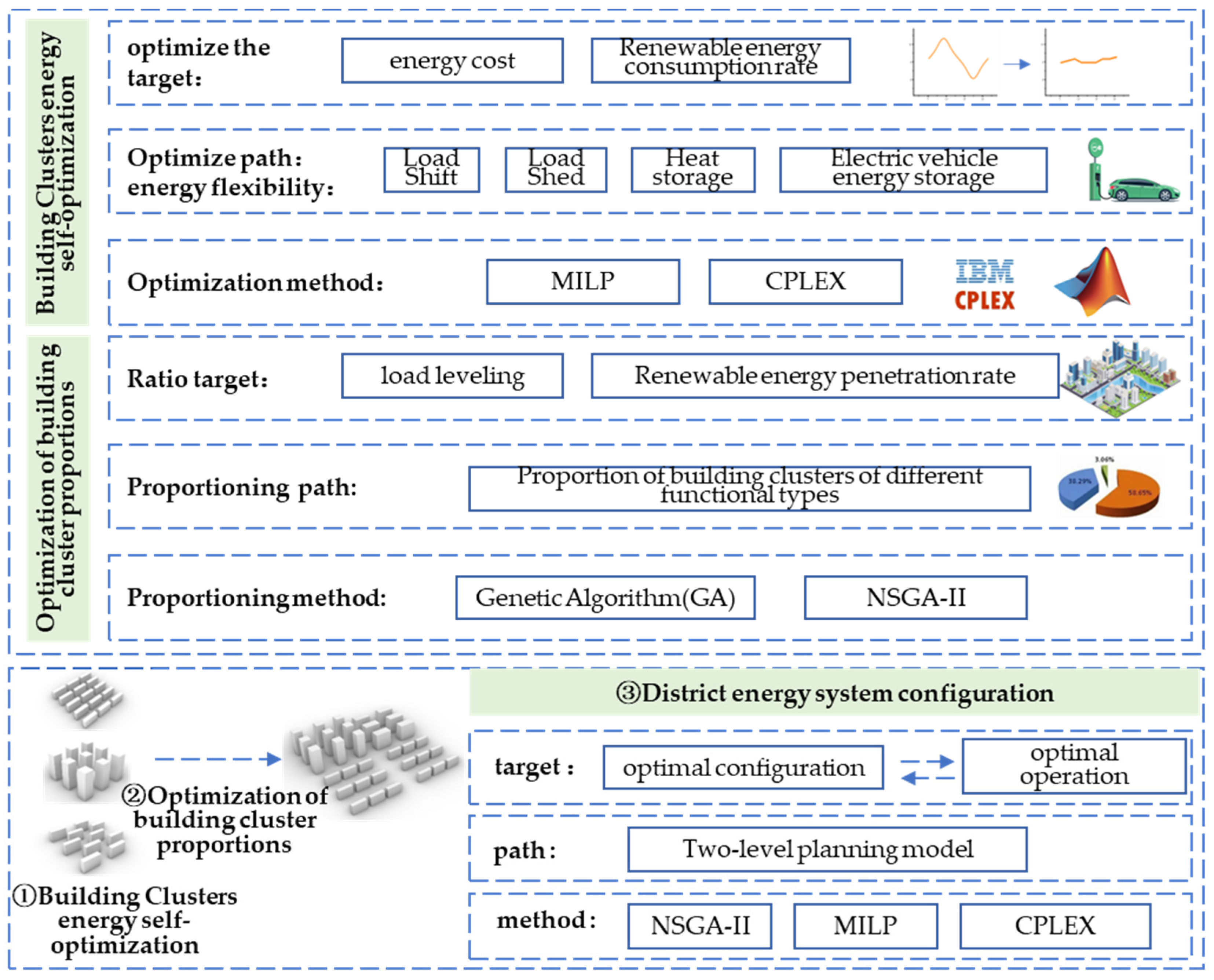
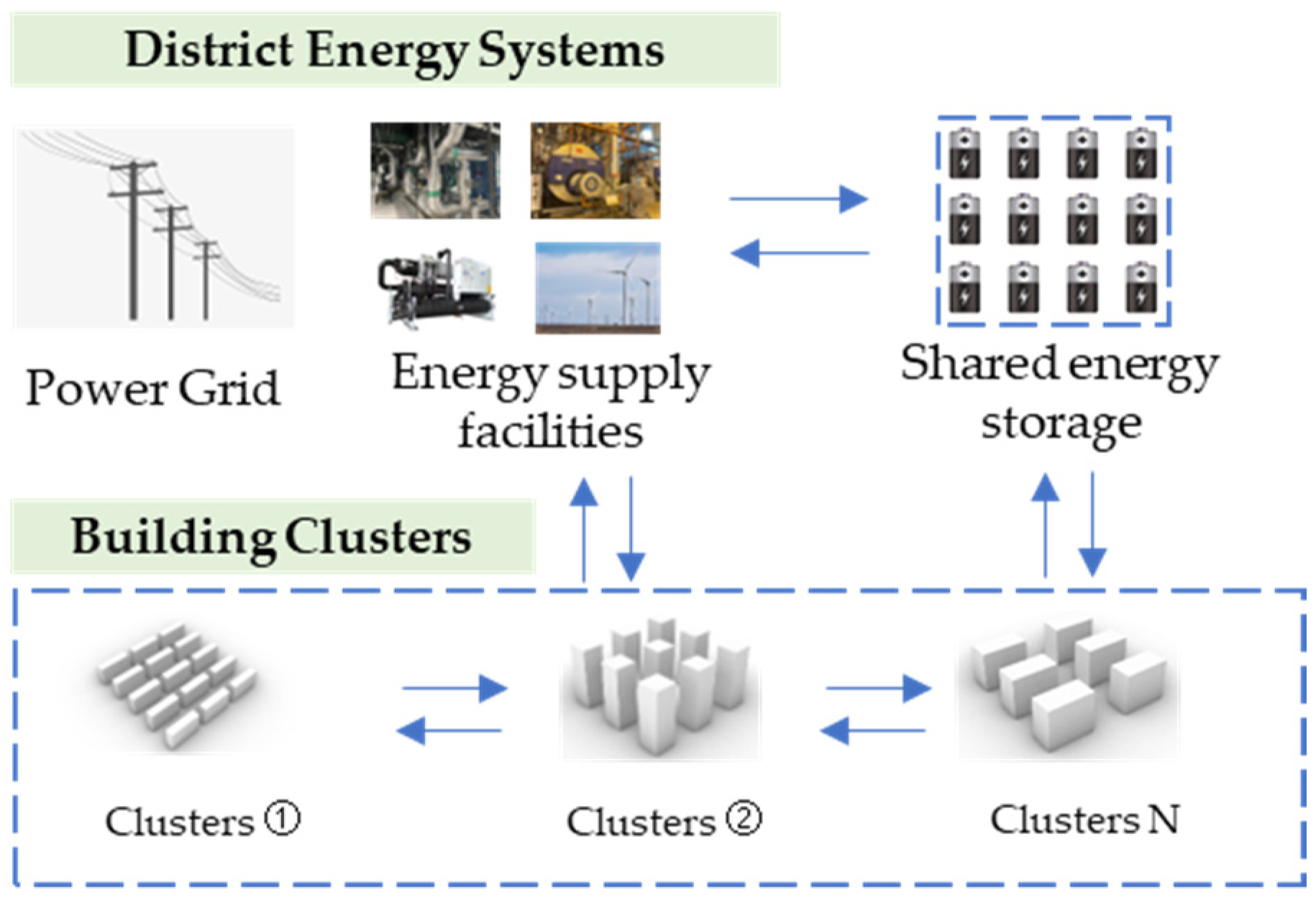
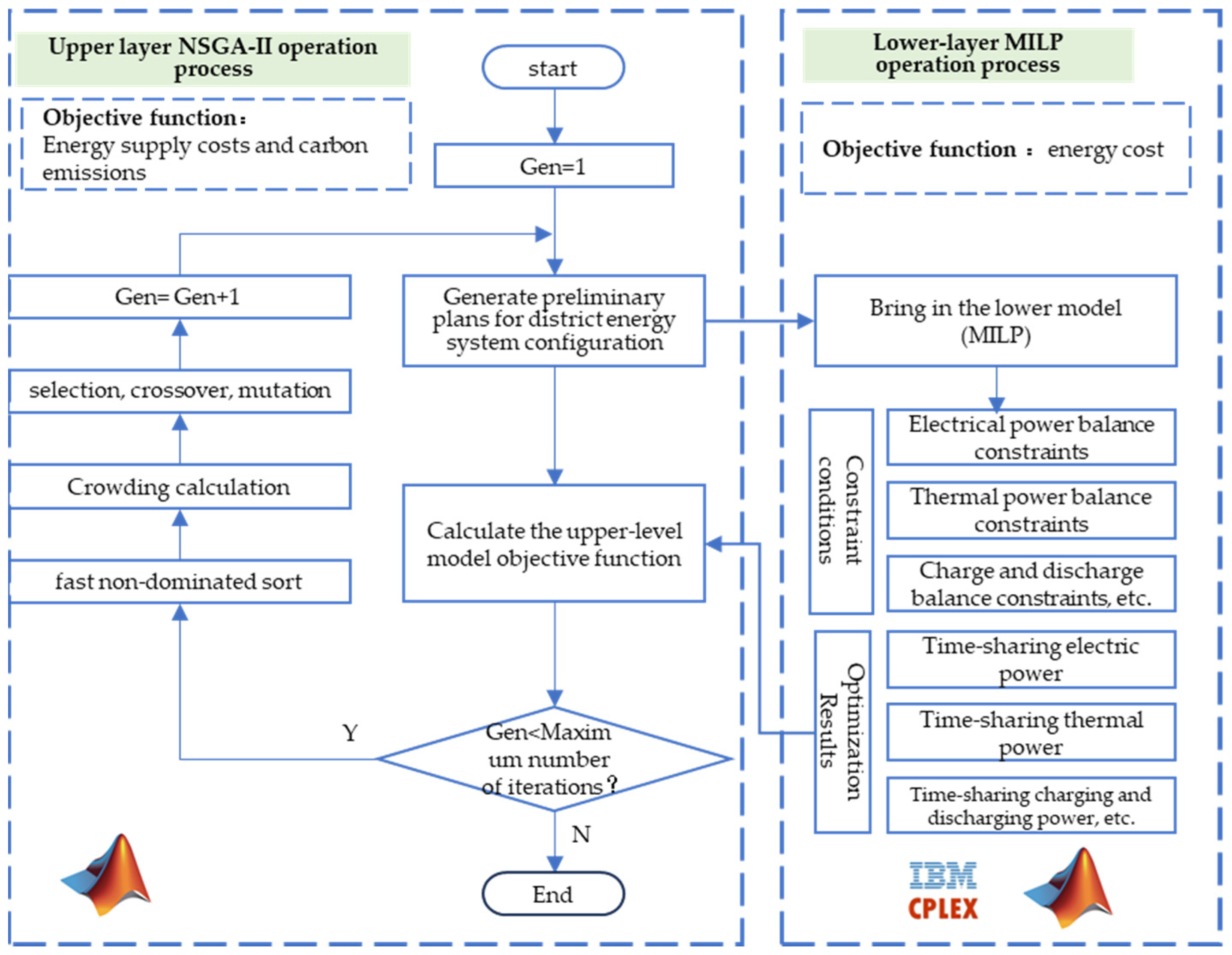

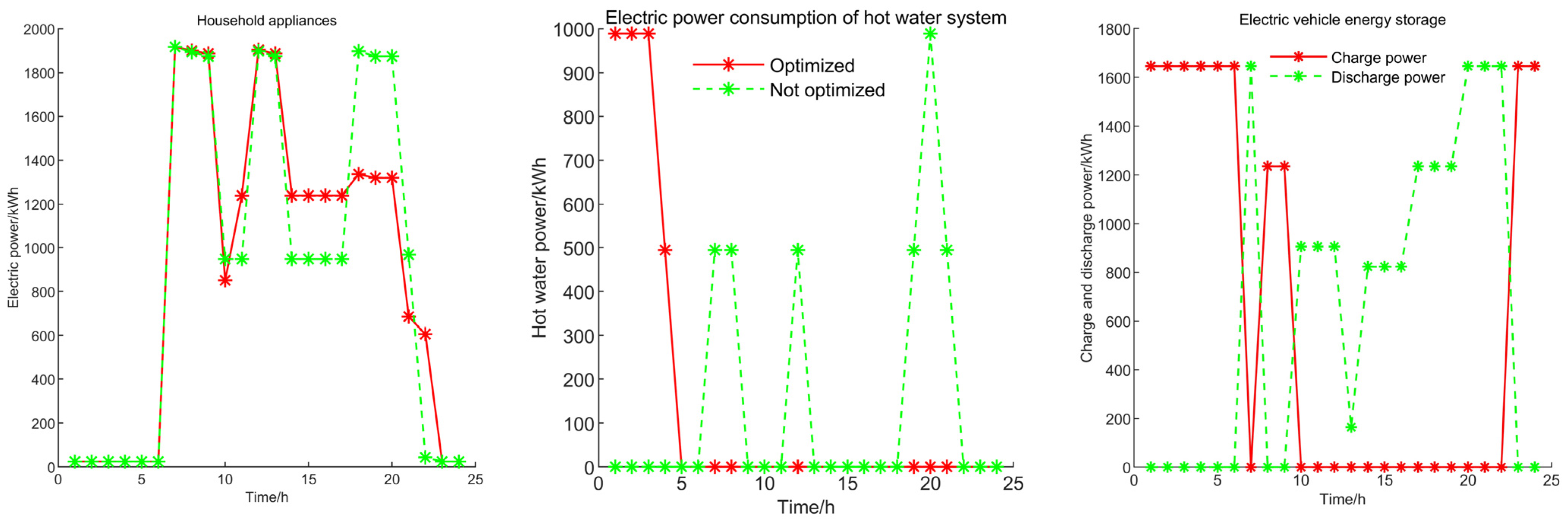
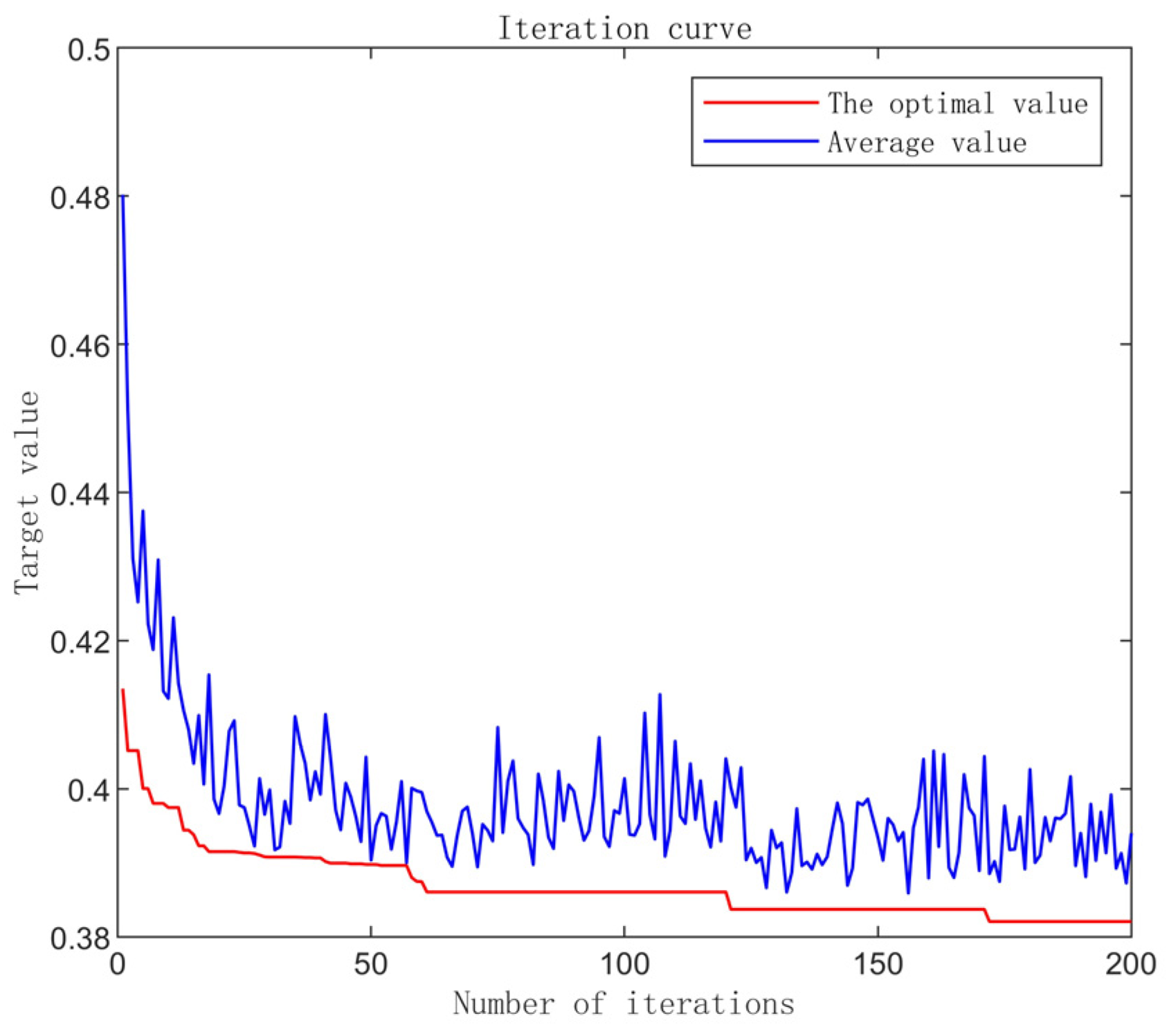
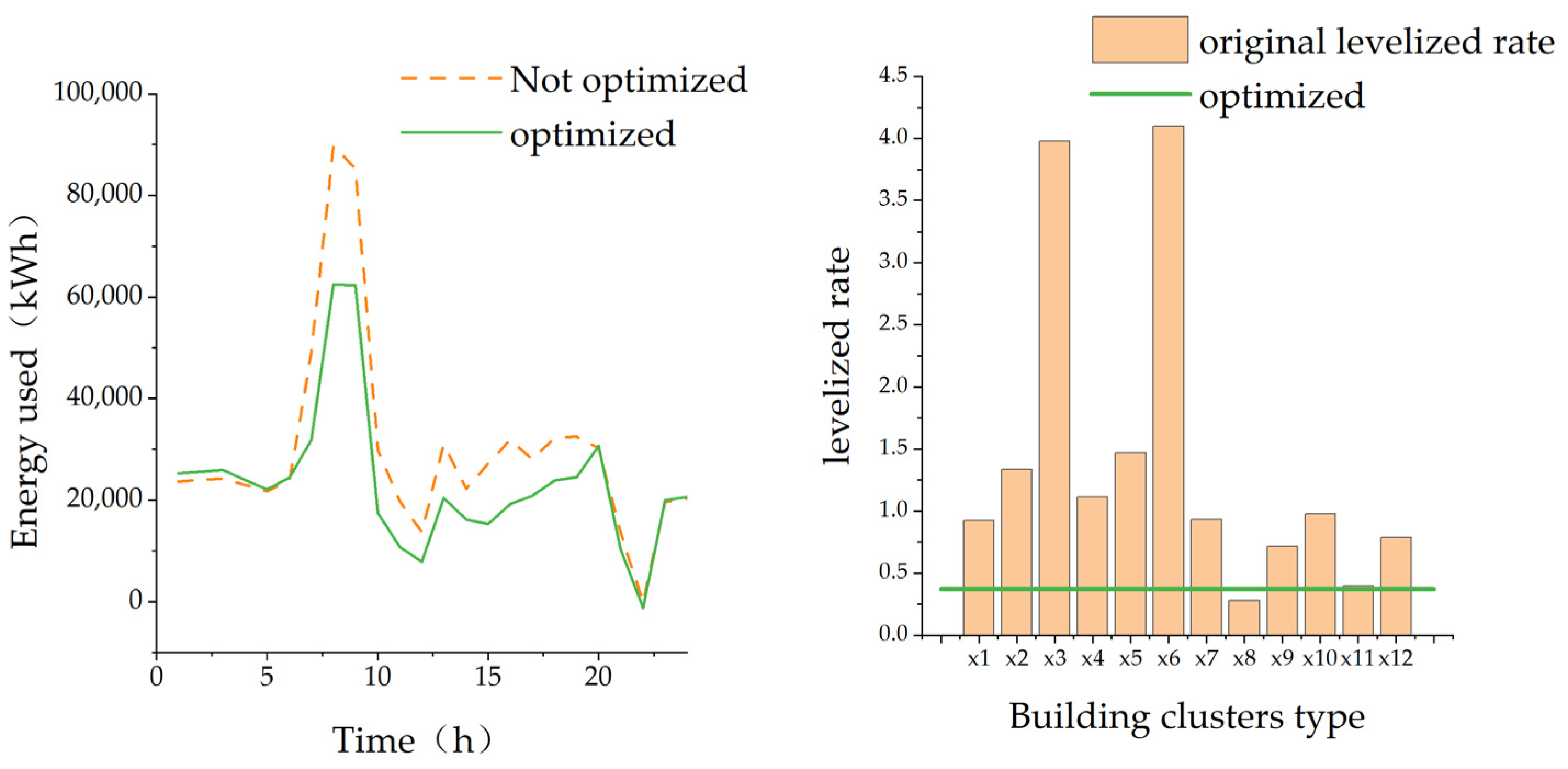

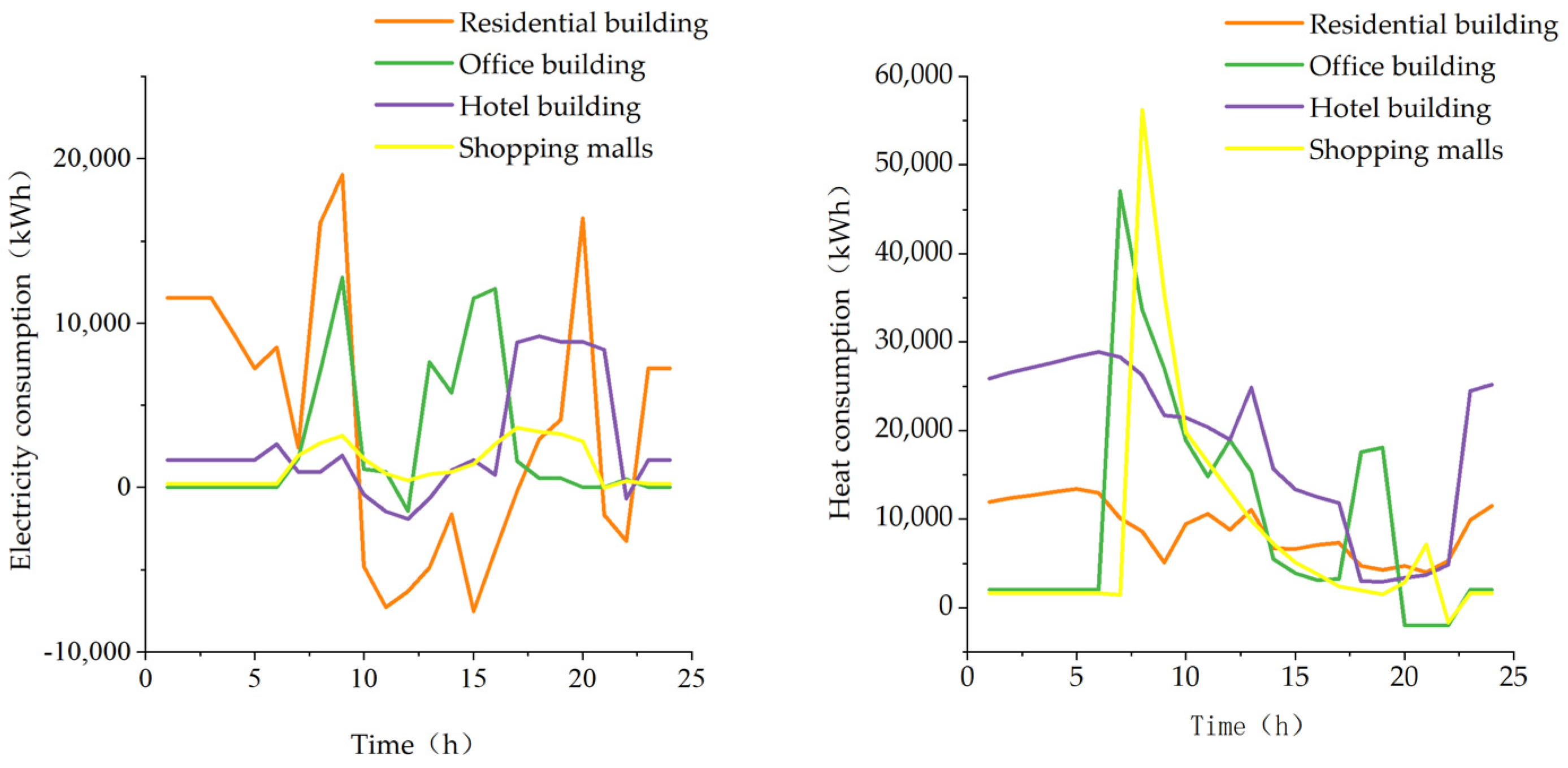



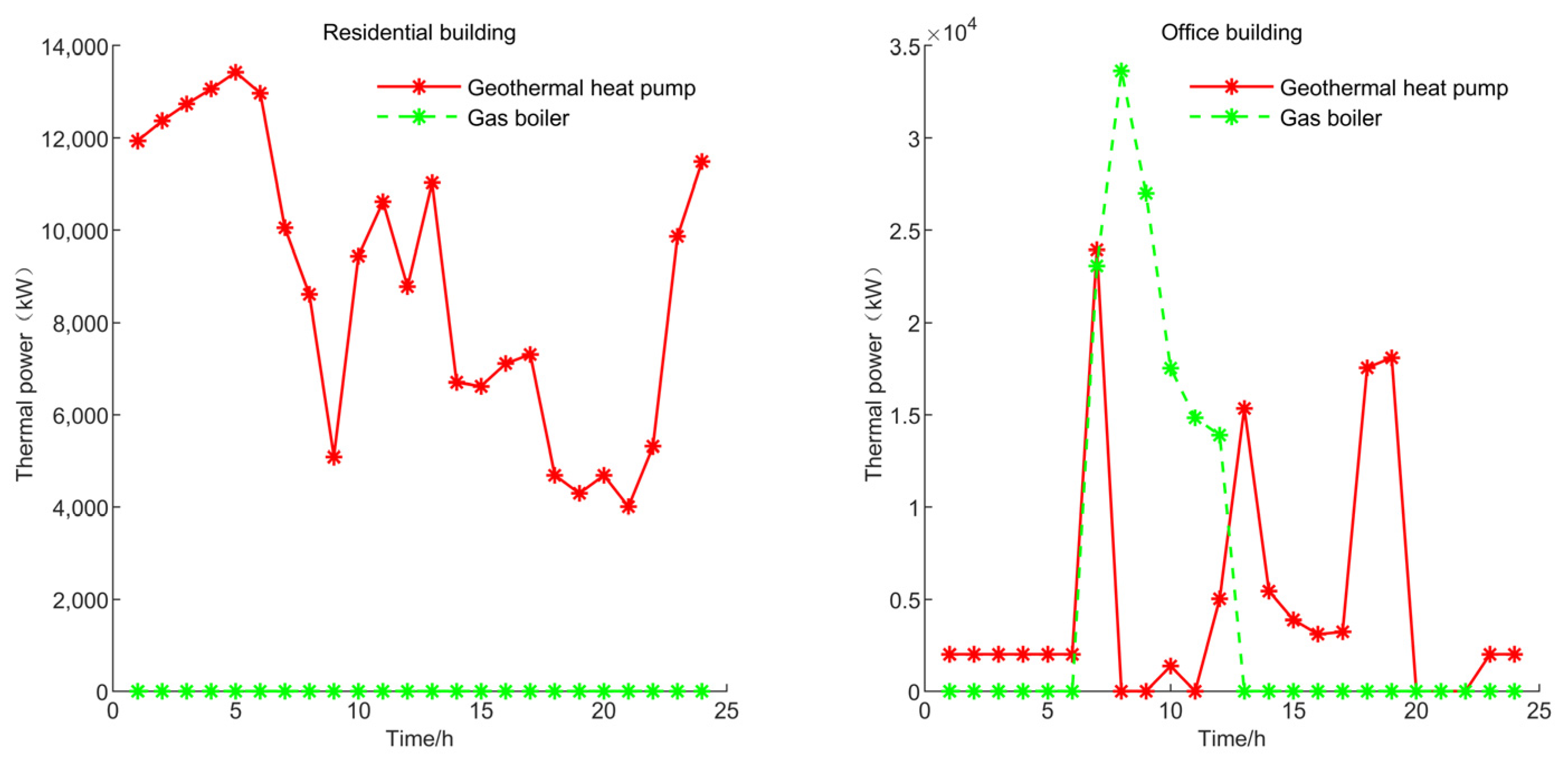
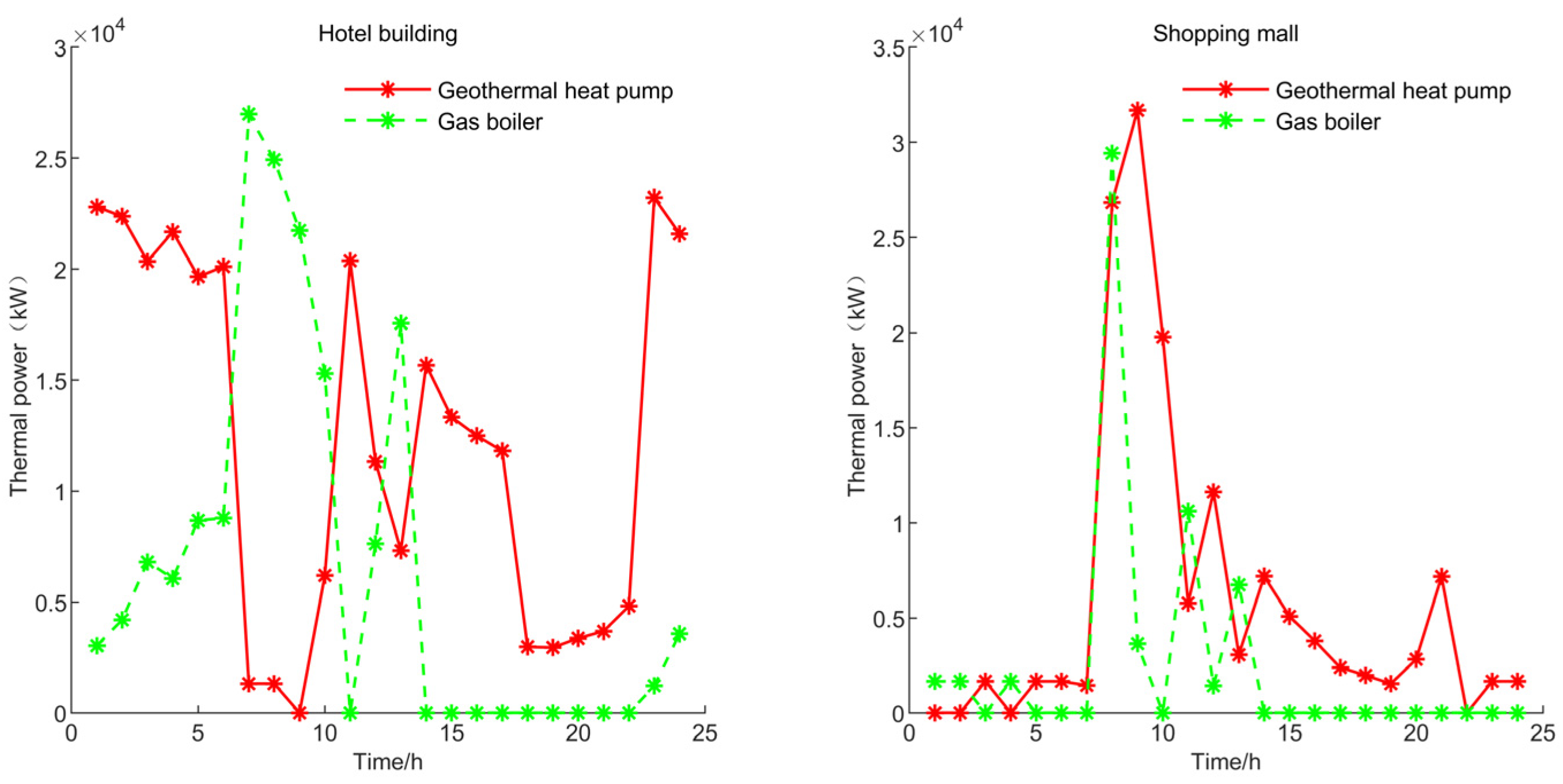
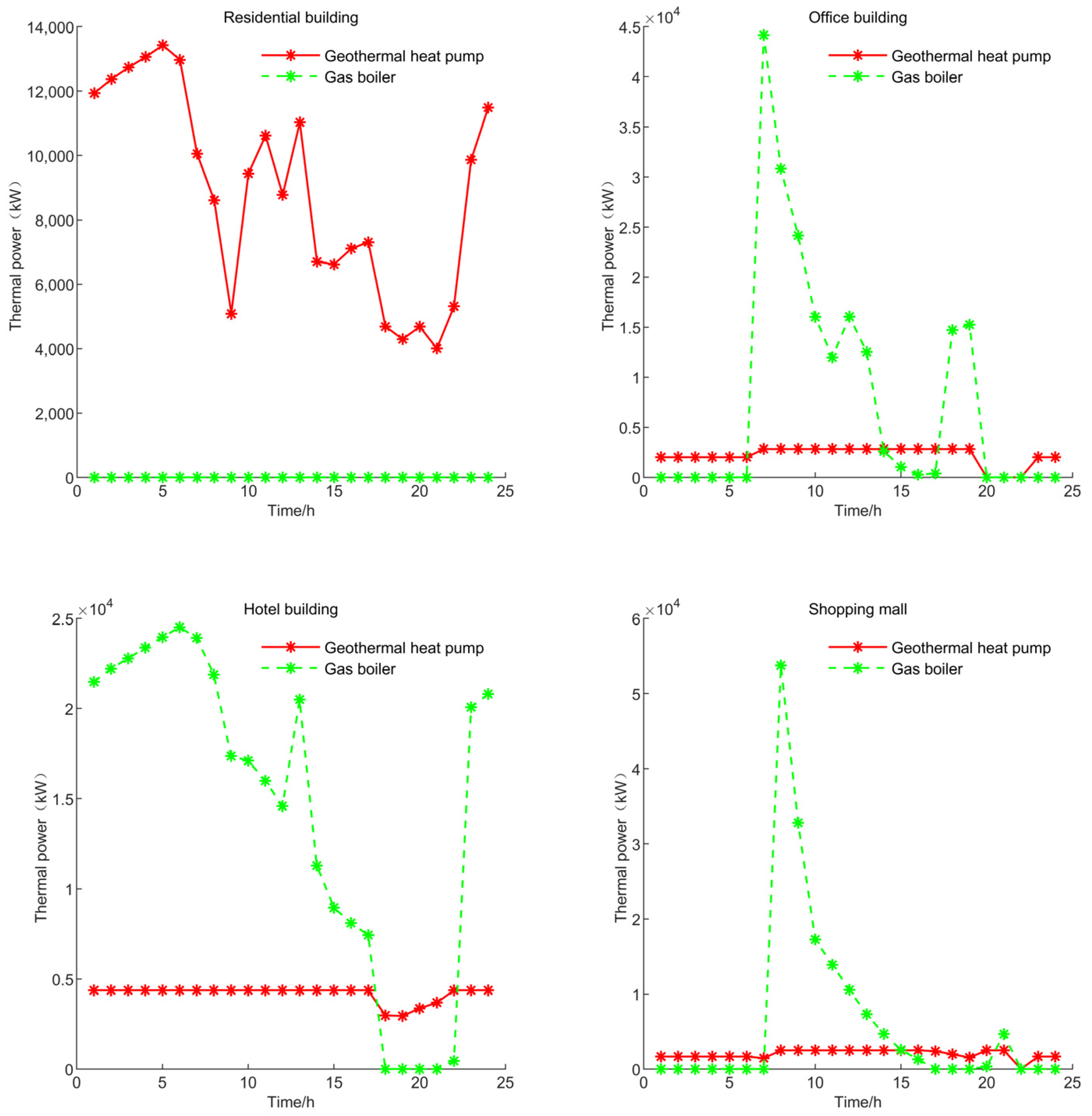
| Residential building clusters |  |  |  |  |  |  |
| number | x1 | x2 | x3 | x4 | x5 | x6 |
| Parameter * | BH: 56 m CA: 480,000 m2 BD: 0.27 | BH: 28 m CA: 288,000 m2 BD: 0.32 | BH: 11.20 m CA: 134,400 m2 BD: 0.37 | BH: 56 m CA: 288,000 m2 BD: 0.16 | BH: 28 m CA: 192,000 m2 BD: 0.21 | BH: 11.20 m CA: 96,000 m2 BD: 0.27 |
| Public building clusters |  |  |  |  |  |  |
| number | x7 | x8 | x9 | x10 | x11 | x12 |
| Parameter * | BF: office BH: 90 m CA: 900,000 m2 BD: 0.36 | BF: hotel BH: 90 m CA: 900,000 m2 BD: 0.36 | BF: shopping mall BH: 45 m CA: 468,000 m2 BD: 0.51 | BF: office BH: 30 m CA: 300,000 m2 BD: 0.36 | BF: hotel BH: 30 m CA: 300,000 m2 BD: 0.36 | BF: shopping mall BH: 22.5 m CA: 234,000 m2 BD: 0.51 |
| Time | 1 | 2 | 3 | 4 | 5 | 6 | 7 | 8 | 9 | 10 | 11 | 12 |
| Hourly electricity price for residential buildings | 0.18 | 0.18 | 0.18 | 0.18 | 0.18 | 0.18 | 0.5 | 0.5 | 0.5 | 0.86 | 0.86 | 0.86 |
| Hourly heat price for residential buildings | 0.16 | 0.16 | 0.16 | 0.16 | 0.16 | 0.16 | 0.4 | 0.4 | 0.4 | 0.7 | 0.7 | 0.7 |
| Hourly electricity price for public buildings | 0.29 | 0.29 | 0.29 | 0.29 | 0.29 | 0.29 | 0.8 | 0.8 | 0.8 | 1.37 | 1.37 | 1.37 |
| Hourly heat price for public buildings | 0.25 | 0.25 | 0.25 | 0.25 | 0.25 | 0.25 | 0.6 | 0.6 | 0.6 | 1.1 | 1.1 | 1.1 |
| Time | 13 | 14 | 15 | 16 | 17 | 18 | 19 | 20 | 21 | 22 | 23 | 24 |
| Hourly electricity price for residential buildings | 0.5 | 0.5 | 0.5 | 0.5 | 0.86 | 0.86 | 0.86 | 0.86 | 0.86 | 0.5 | 0.18 | 0.18 |
| Hourly heat price for residential buildings | 0.4 | 0.4 | 0.4 | 0.4 | 0.7 | 0.7 | 0.7 | 0.7 | 0.7 | 0.4 | 0.16 | 0.16 |
| Hourly electricity price for public buildings | 0.8 | 0.8 | 0.8 | 0.8 | 1.37 | 1.37 | 1.37 | 1.37 | 1.37 | 0.8 | 0.29 | 0.29 |
| Hourly heat price for public buildings | 0.6 | 0.6 | 0.6 | 0.6 | 1.1 | 1.1 | 1.1 | 1.1 | 1.1 | 0.6 | 0.25 | 0.36 |
| Residential building clusters |  x1 |  x2 |  x3 |  x4 |  x5 |  x6 |
| Area ratio | 0.151064 | 0.093926 | 0.055577 | 0.318215 | 0.028666 | 0.045333 |
| Public building clusters |  x7 |  x8 |  x9 |  x10 |  x11 |  x12 |
| Area ratio | 0.07618 | 0.109135 | 0.05 | 0.005314 | 0.016588 | 0.05 |
Disclaimer/Publisher’s Note: The statements, opinions and data contained in all publications are solely those of the individual author(s) and contributor(s) and not of MDPI and/or the editor(s). MDPI and/or the editor(s) disclaim responsibility for any injury to people or property resulting from any ideas, methods, instructions or products referred to in the content. |
© 2024 by the authors. Licensee MDPI, Basel, Switzerland. This article is an open access article distributed under the terms and conditions of the Creative Commons Attribution (CC BY) license (https://creativecommons.org/licenses/by/4.0/).
Share and Cite
Wu, P.; Liu, Y. Methods for Coordinating Optimization of Urban Building Clusters and District Energy Systems. Systems 2024, 12, 92. https://doi.org/10.3390/systems12030092
Wu P, Liu Y. Methods for Coordinating Optimization of Urban Building Clusters and District Energy Systems. Systems. 2024; 12(3):92. https://doi.org/10.3390/systems12030092
Chicago/Turabian StyleWu, Peng, and Yisheng Liu. 2024. "Methods for Coordinating Optimization of Urban Building Clusters and District Energy Systems" Systems 12, no. 3: 92. https://doi.org/10.3390/systems12030092
APA StyleWu, P., & Liu, Y. (2024). Methods for Coordinating Optimization of Urban Building Clusters and District Energy Systems. Systems, 12(3), 92. https://doi.org/10.3390/systems12030092






